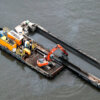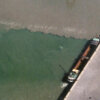CO2 and other emissions / Greenhouse Gases – including from dredging equipment – must be controlled to help mitigate climate change, which requires innovative research.
Intergovernmental Panel on Climate Change
The Intergovernmental Panel on Climate Change (IPCC), a United Nations scientific intergovernmental body established 25 years ago, has reaffirmed that climate change is brought on by human activity and is heating up the planet at an untenable rate and “it is extremely likely that human influence has been the dominant cause of the observed warming since the mid-20th century”. One of these “human influences” is the use of fossil fuels and their emissions. This includes CO2, SOx, NOx and others.
Maritime industry & emissions
While nations are responsible for emissions within their own borders, emissions from international shipping are not bound to one country. Ships move across vast bodies of water. Consequently, the International Maritime Organization (IMO), also an UN agency, has developed legislation addressing the reduction of greenhouse gases caused by fuel emissions. Since emissions vary from one type of ship to another, this is a complex issue. Freight ships, for instance, differ from dredging vessels even if some dredgers are self-propelled and sea-going.
Regulating emissions in dredging vessels
Globally, a progressive reduction in emissions of SOx and Particulate Matter (PM) and the introduction of Emission Control Areas (ECAs) have been gradually enacted. As of January 1, 2015, new limitations on SOx were put in place for parts of the North Sea and the California coast.
Other regulations regarding fuel efficiency and carbon reduction are being put in place by the IMO and the European Union.
Dredging industry initiatives
The dredging industry is working on multiple methods to achieve sustainable growth by improving energy efficiency with regard to emissions. These include:
- an ecosystem-based CO2 foot-printing programme in which during the design phase of a project both equipment emissions and also the emissions throughout the entire chain are examined
- an effort to update equipment which are able to use more sustainable fuels such as biodiesels as well as to install scrubbers on new-built equipment or to retrofit on existing ships
- use of alternative energy sources such as electricity (shore-powered electrically driven dredgers), LNG, dual engines
- the deployment of equipment and making mobilisation and demobilisation of vessels more energy efficient by sailing between projects at lower speeds
- lowering the distances between a project and the borrow pit
- Life Cycle Analysis (LCA) of the environmental impact of a dredging vessel includes its construction (conceptual design), operation and disposal
- the preservation of Blue Carbon ecosystems for sequestering CO2






























